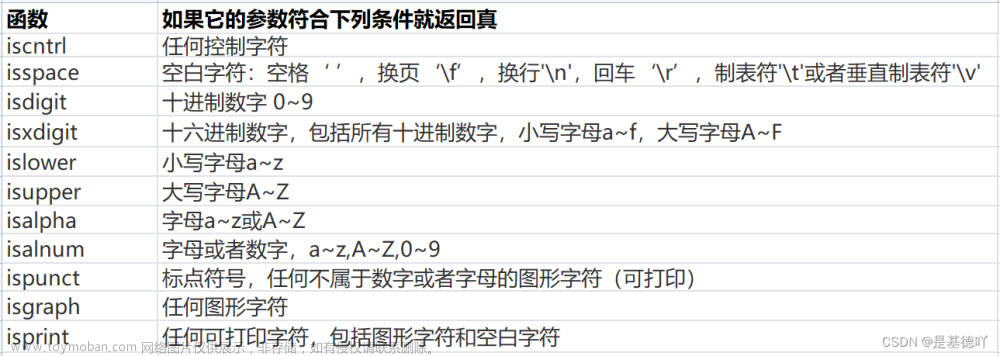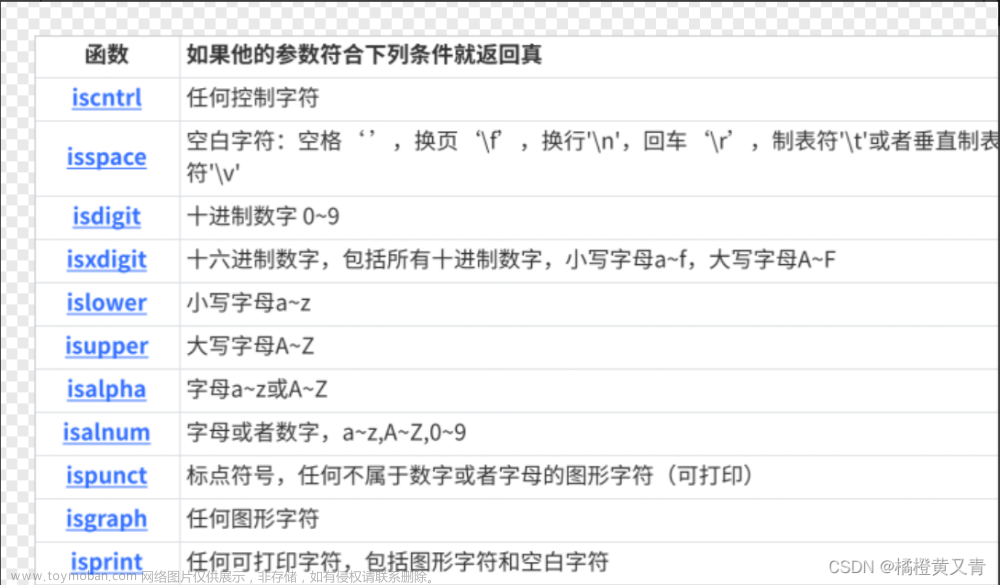
✨个人主页: 熬夜学编程的小林
💗系列专栏: 【C语言详解】 【数据结构详解】
目录
1、strncat 函数的使用
2、strncmp 函数的使用
3、strstr 函数的使用和模拟实现
4、strtok 函数的使用
5、strerror 函数的使用
6、perror 函数的使用
总结文章来源:https://www.toymoban.com/news/detail-830022.html
1、strncat 函数的使用
char * strncat ( char * destination, const char * source, size_t num );• Appends the first num characters of source to destination, plus a terminating null-character.(将source指向字符串的前num个字符追加到destination指向的字符串末尾,再追加⼀个 \0 字符)。• If the length of the C string in source is less than num, only the content up to the terminating null-character is copied.(如果source 指向的字符串的长度小于num的时候,只会将字符串中到 \0 的内容追加到destination指向的字符串末尾)。
/* strncat example */
#include <stdio.h>
#include <string.h>
int main ()
{
char str1[20];
char str2[20];
strcpy (str1,"To be ");//将"To be "拷贝到str1
strcpy (str2,"or not to be");//将"or not to be"拷贝到str2
strncat (str1, str2, 6);//将str2前面6个字符接到str1末尾
printf("%s\n", str1);//打印str1
return 0;
}2、strncmp 函数的使用
int strncmp ( const char * str1, const char * str2, size_t num );比较str1和str2的前num个字符,如果相等就继续往后比较,最多比较num个字母,如果提前发现不⼀样,就提前结束,大的字符所在的字符串大于另外⼀个。如果num个字符都相等,就是相等返回0.
#include <stdio.h>
#include <string.h>
int main()
{
char str1[20];
char str2[20];
strcpy(str1, "abcdef");//将"abcdef"拷贝到str1
strcpy(str2, "abc");//将"abc"拷贝到str2
int ret=strncmp(str1, str2, 4);//将返回值给赋值给ret
if (ret > 0)
printf("str1 > str2\n");
else if (ret < 0)
printf("str1 < str2\n");
else
printf("str1 == str2\n");
return 0;
}
3、strstr 函数的使用和模拟实现
char * strstr ( const char * str1, const char * str2);Returns a pointer to the first occurrence of str2 in str1, or a null pointer if str2 is not part of str1.(函数返回字符串str2在字符串str1中第⼀次出现的位置)。The matching process does not include the terminating null-characters, but it stops there.(字符串的比较匹配不包含 \0 字符,以 \0 作为结束标志)。
/* strstr example */
#include <stdio.h>
#include <string.h>
int main ()
{
char str[] ="This is a simple string";
char * pch;
pch = strstr (str,"simple");//找到与simple相等的首地址赋值给pch
strncpy (pch,"sample",6);//将sample前6个字符拷贝到pch 即修改str中的simple
printf("%s\n", str);//打印str
return 0;
}
char * strstr (const char * str1, const char * str2)
{
char *cp = (char *) str1;//str1为const修饰指针,需强制转化为可改指针
char *s1, *s2;
if ( !*str2 )//str2为空返回str1首地址
return((char *)str1);//返回值为char*,需强转成char*
while (*cp)
{
s1 = cp;
s2 = (char *) str2;
while ( *s1 && *s2 && !(*s1-*s2) )//*s1 s2不为'\0'且*s1==*s2,
s1++, s2++;
if (!*s2)//*s2为'\0'则返回cp
return cp;
cp++;//否则cp++
}
return NULL;//没有找到则返回NULL
}4、strtok 函数的使用
char * strtok ( char * str, const char * sep);• sep参数指向⼀个字符串,定义了用作分隔符的字符集合• 第⼀个参数指定⼀个字符串,它包含了0个或者多个由sep字符串中⼀个或者多个分隔符分割的标记。• strtok函数找到str中的下⼀个标记,并将其用 \0 结尾,返回⼀个指向这个标记的指针。(注: strtok函数会改变被操作的字符串,所以在使用strtok函数切分的字符串⼀般都是临时拷贝的内容并且可修改。)• strtok函数的第⼀个参数不为 NULL ,函数将找到str中第⼀个标记,strtok函数将保存它在字符串中的位置。• strtok函数的第⼀个参数为 NULL ,函数将在同⼀个字符串中被保存的位置开始,查找下⼀个标记。• 如果字符串中不存在更多的标记,则返回 NULL 指针。
#include <stdio.h>
#include <string.h>
int main()
{
char arr[] = "192.168.6.111";
char* sep = ".";
char* str = NULL;
for (str = strtok(arr, sep); str != NULL; str = strtok(NULL, sep))
{
printf("%s\n", str);
}
return 0;
}5、strerror 函数的使用
char * strerror ( int errnum );strerror函数可以把参数部分错误码对应的错误信息的字符串地址返回来。在不同的系统和C语⾔标准库的实现中都规定了⼀些错误码,⼀般是放在 errno.h 这个头文件中说明的,C语言程序启动的时候就会使用⼀个全面的变量errno来记录程序的当前错误码,只不过程序启动的时候errno是0,表示没有错误,当我们在使用标准库中的函数的时候发⽣了某种错误,就会讲对应的错误码,存放在errno中,而⼀个错误码的数字是整数很难理解是什么意思,所以每⼀个错误码都是有对应的错误信息的。strerror函数就可以将错误对应的错误信息字符串的地址返回。
#include <errno.h>
#include <string.h>
#include <stdio.h>
//我们打印⼀下0~10这些错误码对应的信息
int main()
{
int i = 0;
for (i = 0; i <= 10; i++) {
printf("%s\n", strerror(i));
}
return 0;
}No error 没有错误
Operation not permitted 不允许操作
No such file or directory 没有这样的文件或目录
No such process 没有这样的过程
Interrupted function call 中断的函数调用
Input/output error 输入/输出误差
No such device or address 没有这样的设备或地址
Arg list too long 参数列表太长
Exec format errorExec 格式错误
Bad file descriptor 错误的文件描述符
No child processes 无子进程
#include <stdio.h>
#include <string.h>
#include <errno.h>
int main ()
{
FILE * pFile;
pFile = fopen ("unexist.ent","r");
if (pFile == NULL)
printf ("Error opening file unexist.ent: %s\n", strerror(errno));
return 0;
} Error opening file unexist.ent: No such file or directory6、perror 函数的使用
void perror ( const char * str );将 errno 的值解释为错误消息,并将其打印到 stderr(标准错误输出流,通常是控制台),可以选择在它前面加上 str 中指定的自定义消息。
#include <stdio.h>
#include <string.h>
#include <errno.h>
int main ()
{
FILE * pFile;
pFile = fopen ("unexist.ent","r");
if (pFile == NULL)
perror("Error opening file unexist.ent");
return 0;
}Error opening file unexist.ent: No such file or directory总结
本篇博客就结束啦,谢谢大家的观看,如果公主少年们有好的建议可以留言喔,谢谢大家啦!文章来源地址https://www.toymoban.com/news/detail-830022.html
到了这里,关于C语言第二十六弹---字符串函数(下)的文章就介绍完了。如果您还想了解更多内容,请在右上角搜索TOY模板网以前的文章或继续浏览下面的相关文章,希望大家以后多多支持TOY模板网!
















